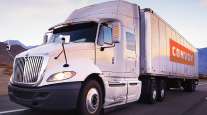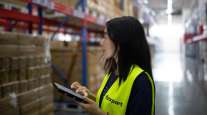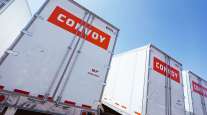Staff Reporter
Convoy Unveils Machine-Learning System to Assess Carrier Safety

[Ensure you have all the info you need in these unprecedented times. Subscribe now.]
Convoy unveiled a new machine-learning system that’s designed to assess carriers’ safety histories, the company announced June 24.
The system processes millions of records daily to better correlate the relationship between carrier safety events and related crash data, and identifies carriers that it will allow into its network. The system automatically updates over time as data is inputted.
“It’s a machine-learning model that looks at records, and it’s looking at thousands of records across every carrier,” Lorin Seeks, director of carrier quality and compliance at Convoy, told Transport Topics.
Safety events include everything from on-road violations to vehicle maintenance. Records in the system can include roadside inspections, noncompliance issues, moving violations and road accidents.
Our new safety initiative uses machine-learning and automation to create a safer carrier network, with crash rates 16% below the industry. https://t.co/fKFndxmVvF pic.twitter.com/yPeMNcXQ4B — Convoy Team (@convoyteam) June 24, 2020
Convoy operates a digital freight matching network and is based out of Seattle. It utilizes and builds technology such as smartphone applications to find new ways to connect shippers with carriers.
“When you look at every carrier in our network going back 10 years, that’s millions of records,” Seeks said. “Every time that data updates we’re refreshing that information. A record is a single unique safety event or carrier attribute. Those records are transformed into inputs for the model.”
Convoy sees its system as an alternative to federal data, including Federal Motor Carrier Safety Administration safety records.

COVID-19 has placed significant strain on many freight networks. So how are third-party logistics providers adapting to meet these challenges? Host Seth Clevenger chats with two 3PL executives who have had firsthand experience contending with this crisis. Hear a snippet, above, and get the full program by going to RoadSigns.TTNews.com.
Seeks said the system has been under development for the past nine months. Testing so far has shown promising results, with carriers in the system being involved in 16% fewer accidents than the industry average.
Seeks said the system will be used for carriers already participating as well as others that want to join. The onboarding phase will take data provided by the carrier along with sources such as federal statistics to determine whether a carrier qualifies to join. Once a carrier is in the network the system, or model, will continue to update the data.
“Every single carrier in our network gets a score regardless of how small or big they are. And it’s calculated from the model prediction. So that’s number of crashes over the next 12 months, normalized by the number of power units the carrier has,” Seeks said.
He added, “Each carrier in the network is ultimately assigned a percentile ranking. So that’s the output of the model. We’re taking all these thousands of records about a carrier, and what the model is doing is finding the strongest correlations with crashes. The model learns over time. As the data changes and we get new data, it finds better and better ways to correlate crashes with the carriers’ history.”
Want more news? Listen to today's daily briefing:
Subscribe: Apple Podcasts | Spotify | Amazon Alexa | Google Assistant | More




